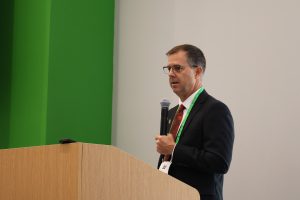How balancing production cost control and efficiency can change your operation
by Lauren Gatz, Beef Improvement Federation intern

“Improving production or output is important, but in most publications, controlling costs trumps increasing output.” said Dave Lalman, Oklahoma State University. In commercial cow-calf operations, cow cost accounts for about 60 to 65% of the variation in profitability whereas increasing production (number of calves and calf weaning weight) accounts for about 35 to 40% of the variation in profitability. Lalman was a featured speaker during the 2024 Beef Improvement Federation (BIF) Symposium June 11 in Knoxville, Tennessee.
Lalman’s presentation emphasized that efficiency in cow-calf operations goes beyond just boosting production; it’s about maximizing the return on every dollar invested and ensuring that resources are used as effectively as possible.
Economical forage production combined with efficient and timely forage harvest (grazing) generally represents the lowest hanging fruit to improve whole-ranch profitability and efficiency. “Building a better cow might be viewed as getting better at something beef cattle do well already,” he explained. “Harvesting sunlight, carbon dioxide, and water to produce a delicious, nutritious human food source.”
The industry has applied aggressive selection pressure to increase post-weaning growth and carcass weight. This selection pressure has led to an increase in mature cow weight. “In fact, over a 30-year career, assuming a ranch manager used herd sires representing only industry average growth and carcass weight, the operation’s cows would weigh about 230 pounds more today. That increase in mature cow body weight relates to about a 13% reduction in stocking capacity to apply the same grazing pressure on a given land base,” he said.
Today, several breed associations produce and publish mature cow weight expected progeny differences (EPDs). This selection tool can be used to control mature cow size and indirectly, stocking capacity on the ranch.
Lalman provided data indicating a moderate, positive phenotypic correlation between forage diet intake and a concentrate-based diet intake over several experiments. Surprisingly, in these same studies, there was no relationship between forage diet weight gain and concentrate diet weight gain. He summarized these studies by suggesting that feed intake EPDs provided by breed associations may work reasonably well to control feed intake in the cow herd. Secondly, he suggested that weight gain based on high-quality concentrate diets may not reflect the ability of cattle to thrive in a forage environment, especially a low-quality forage environment.
Lalman shared data from 353 proven Angus sires (above 0.5 accuracy for feed intake and mature cow weight EPD). From this data he demonstrated that there are numerous proven Angus sires that are expected to produce females with above average mature cow weight but below average feed intake. He also pointed out a few sires with below breed average mature cow weight and above breed average feed intake. “Mature cow weight is a good place to start to control feed intake in the cow herd, but mature weight is an indicator trait. It is a proxy used to produce an estimate of feed intake and it isn’t always an accurate estimate of an animal’s genetic capacity. Similarly, we have demonstrated that the feed intake EPD should work reasonably well for a cow consuming forage. Perhaps we should be using these two traits in combination to identify cows that have modest appetite but are highly productive”.
Lalman also shared data generated over the past few years in their research program at Oklahoma State University related to the influence of milk yield on feed intake. In general, their group has found that beef cows’ forage intake is more sensitive to milk yield than previously thought and previously published by the National Academy of Sciences, Engineering, and Medicine’s Nutrient Requirements of Beef Cattle. “Our data suggests that each one-pound increase in milk yield is associated with about 0.4 pounds increase in feed intake. The previously published coefficient was half that at 0.2,” he said.
Lalman’s presentation provided a comprehensive overview of cow efficiency, emphasizing that building better cows isn’t just about boosting production — it’s about creating a balanced, cost-effective, and sustainable operation. By focusing on cost control, thoughtful genetic selection, and efficient feed use, cattle producers can improve the overall efficiency of their operations, ultimately leading to greater profitability and long-term success.
To watch the full presentation, visit https://youtu.be/ZXWJaqpLVx0?si=2Ktp28yvkv0nhqar. For more information about this year’s Symposium and the Beef Improvement Federation, including additional presentations and award winners, visit BIFSymposium.com.
